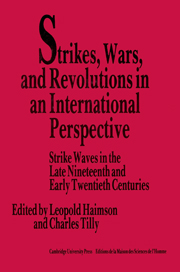 Strikes, Wars, and Revolutions in an International Perspective
Strikes, Wars, and Revolutions in an International Perspective Published online by Cambridge University Press: 25 March 2010
Industrial conflict is volatile
The temporal patterns of strikes do not resemble those of births, or school attendance, or traffic accidents. Births, school attendance, traffic accidents, and many other repetitive social phenomena display a kind of quantitative inertia: One year's pattern usually resembles the previous year's quite closely, and large changes only occur gradually.
Strikes differ emphatically from such cumulative social phenomena; they veer rapidly in location and number from one period to the next. To be sure, the frequency of strikes varies with the season in construction, schoolteaching, and a number of other trades that have annual production cycles. The periodicity of labor contracts affects the rhythm of industrial conflict. And to the extent that the business cycle follows a regular pattern – a much-disputed subject – so do the ebb and flow of strikes. Yet a glance at almost any national strike series shows large swings in frequency and amplitude from month to month and year to year. Indeed, strikes often arrive in great waves that wash over an entire region or country.
The volatility of strike activity resembles that of open political struggle. As represented by demonstrations, marches, meetings, petitions, partisan attacks, and related forms of contention, political struggles shift rapidly from pallid to intense, from small to immense. War, revolution, rebellion, and other forms of strategic interaction likewise swing quickly. When multiple parties struggle openly for advantage, volatility becomes the rule.
Why should that be? Three related features of strategic interaction contribute to its rapid variations in intensity.
To save this book to your Kindle, first ensure [email protected] is added to your Approved Personal Document E-mail List under your Personal Document Settings on the Manage Your Content and Devices page of your Amazon account. Then enter the ‘name’ part of your Kindle email address below. Find out more about saving to your Kindle.
Note you can select to save to either the @free.kindle.com or @kindle.com variations. ‘@free.kindle.com’ emails are free but can only be saved to your device when it is connected to wi-fi. ‘@kindle.com’ emails can be delivered even when you are not connected to wi-fi, but note that service fees apply.
Find out more about the Kindle Personal Document Service.
To save content items to your account, please confirm that you agree to abide by our usage policies. If this is the first time you use this feature, you will be asked to authorise Cambridge Core to connect with your account. Find out more about saving content to Dropbox.
To save content items to your account, please confirm that you agree to abide by our usage policies. If this is the first time you use this feature, you will be asked to authorise Cambridge Core to connect with your account. Find out more about saving content to Google Drive.